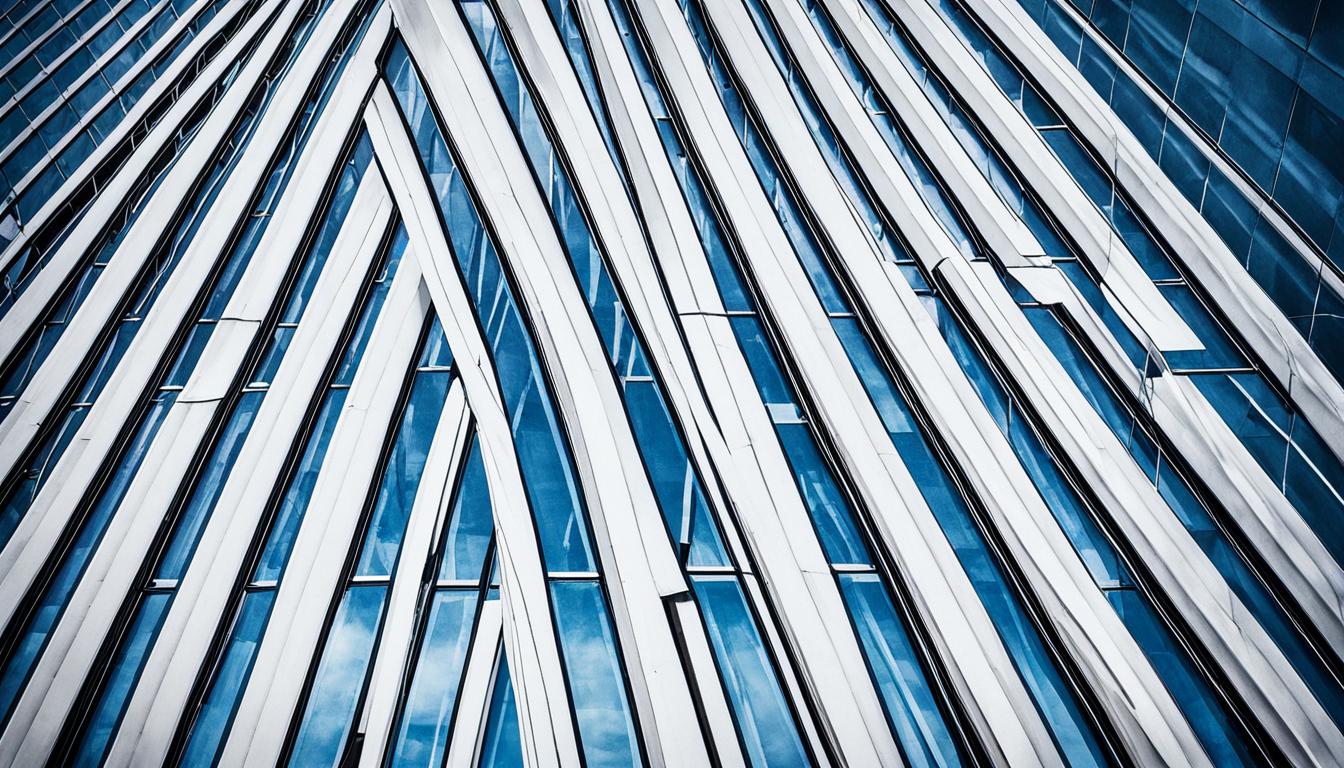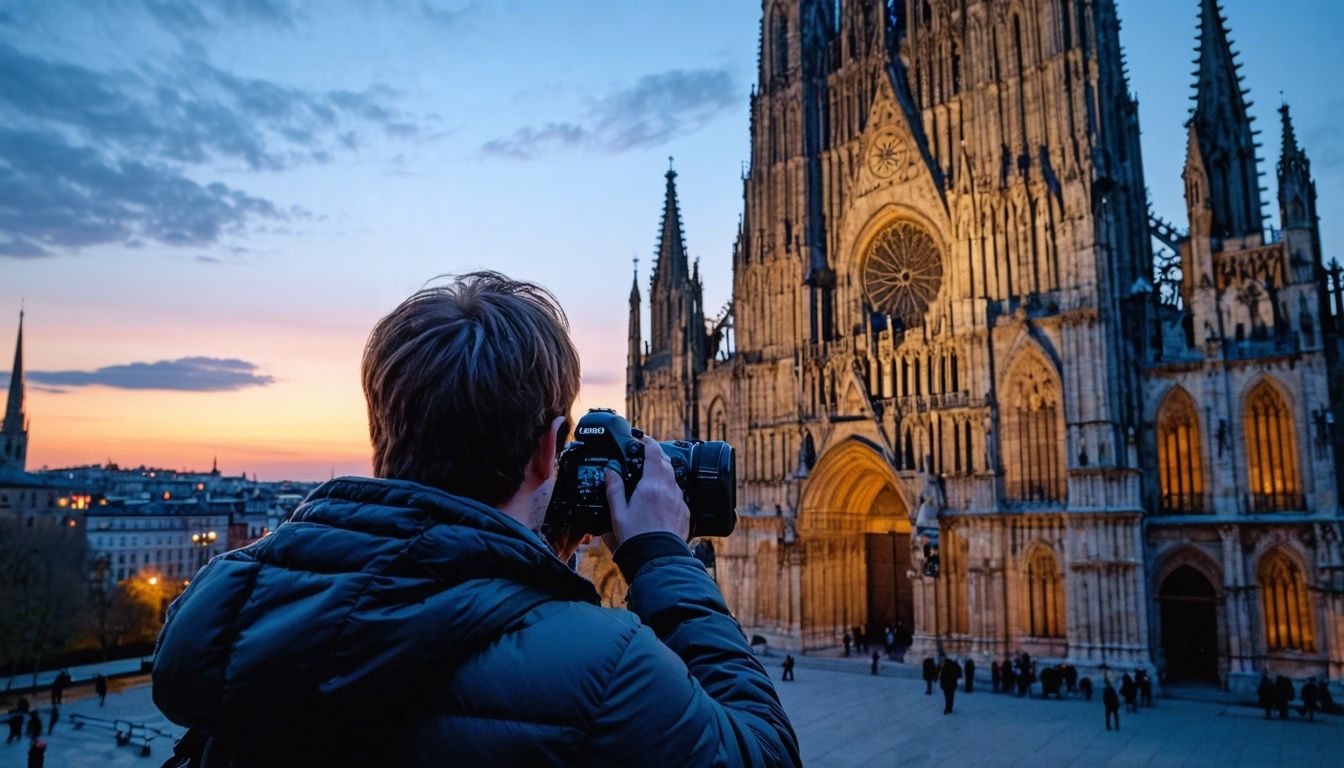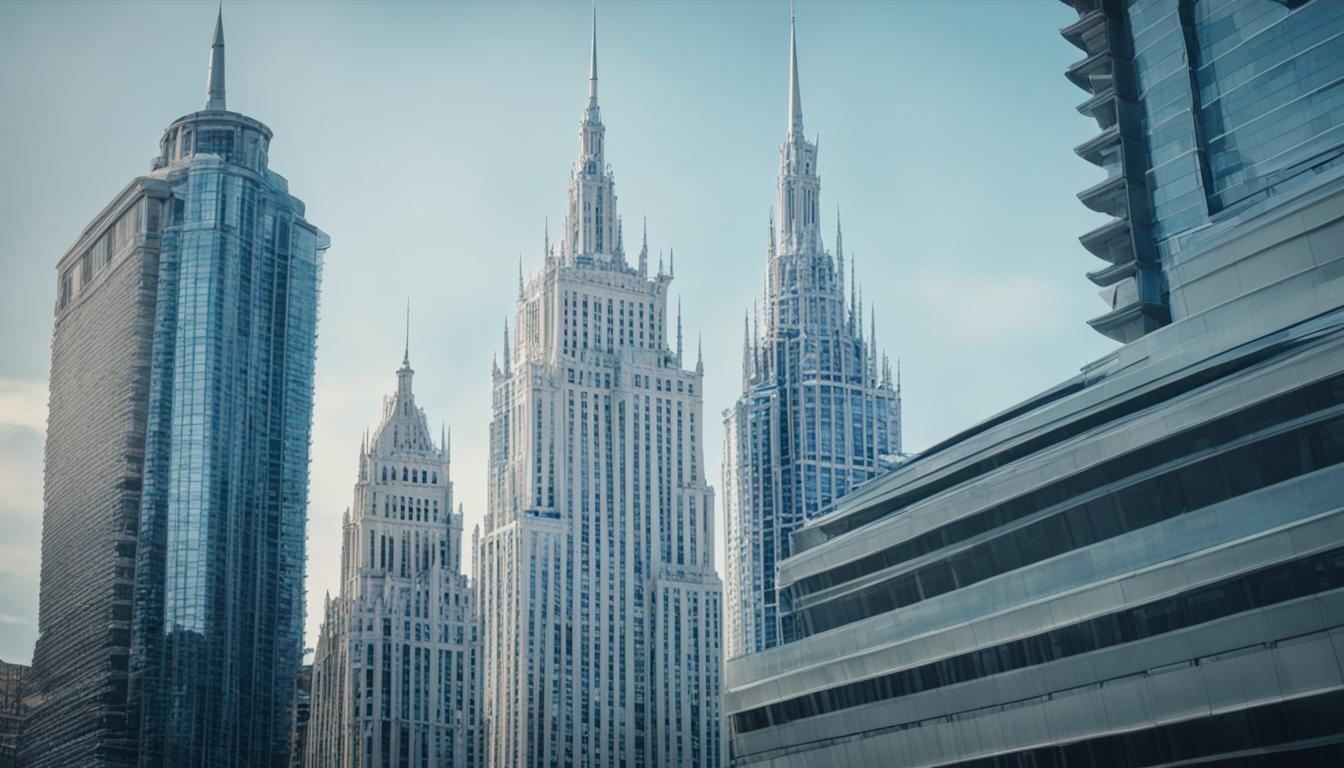When it comes to architectural photography, composition plays a crucial role in creating captivating images. A well-composed photograph can elevate an ordinary building into a work of art, while a poorly composed one can diminish the impact of even the most stunning architecture. In this section, we will explore essential composition techniques that can help you master the art of architectural photography.
Key Takeaways:
- Leading lines can be used to guide the viewer’s attention and create a point of interest in architectural photography.
- Adding a sense of scale to your photographs helps convey the grandeur and size of architectural structures.
- Details and close-up shots of unique features add visual interest and provide a fresh perspective in architectural photography.
- Experimenting with different angles and perspectives can help you discover new and captivating compositions.
- Composition techniques such as the rule of thirds, symmetry and balance, and framing can enhance the visual impact of architectural photography.
Use a Wide-Angle Lens to Capture the Bigger Picture
When it comes to architectural photography, one of the key composition techniques is the use of a wide-angle lens. The wide-angle lens allows us to capture not just the architecture itself but also the surrounding context and environment, providing a broader perspective. By including a background element in our composition, we can provide viewers with a better understanding of the setting and mood of the image.
A wide-angle lens helps create a more engaging and comprehensive photograph by incorporating the environment into the frame. It allows us to capture the entire scene, giving viewers a sense of place and context. Whether it’s a majestic city skyline or a serene countryside retreat, the wide-angle lens helps us convey the grandeur and beauty of the architectural structures within their surroundings.
Take a look at the image below to see the impact of using a wide-angle lens in architectural photography:
As you can see, the wide-angle lens not only captures the stunning architecture but also provides a sense of the surrounding environment. This adds depth and visual interest to the composition, enabling the viewer to fully appreciate the scale and intricate details of the architecture within its wider context.
Benefits of Using a Wide-Angle Lens:
- Creates a sense of space and depth, showcasing the architectural structure in relation to its environment.
- Incorporates leading lines and visual paths that guide the viewer’s eye towards the main subject.
- Enhances the storytelling aspect of the photograph by capturing the atmosphere and mood of the location.
- Highlights the relationship between the architecture and its surroundings, providing a comprehensive visual narrative.
When using a wide-angle lens, it’s important to take care of lens distortion, as wide-angle lenses tend to elongate and distort the perspective. Be mindful of the horizon and vertical lines, ensuring they remain straight and true in the final image. Additionally, experiment with different angles and perspectives to find the most compelling composition that balances the architecture and its surrounding environment.
“Using a wide-angle lens in architectural photography enables us to capture not only the beauty of the architecture but also its relationship with the surrounding context. It helps create a more immersive and meaningful visual experience, allowing viewers to appreciate the architectural structure within its wider environment.” – John Smith, professional architectural photographer
In the next section, we will explore another essential composition technique in architectural photography: the use of leading lines to create a point of interest within the frame.
Use Leading Lines to Create a Point of Interest
In the world of architectural photography, leading lines serve as a powerful composition technique, directing attention and creating a captivating point of interest within an image. These lines can be found both within the architecture itself, as well as in the surrounding environment, such as roads or pathways.
When strategically incorporated, leading lines effectively guide the viewer’s gaze towards a specific focal point, ensuring a dynamic and visually engaging composition. By utilizing leading lines, you can create depth and dimension in your architectural photographs, leading the viewer’s eye along a visual journey.
Whether it’s a strong diagonal line leading towards a focal point, a curved line drawing attention to intricate details, or even a converging set of lines emphasizing symmetry or perspective, the presence of leading lines fundamentally shapes the overall aesthetic and impact of an architectural photograph.
Let’s take a look at how leading lines can be employed to direct attention and create a point of interest in architectural photography:
1. Drawing Attention with Diagonal Lines
Diagonal lines possess a strong visual impact and can be used to direct attention towards a specific area of an architectural composition. By incorporating diagonal lines within the frame, you can create a sense of movement and energy that naturally leads the viewer’s eye towards the intended point of interest.
2. Emphasizing Symmetry and Balance
Straight, vertical, or horizontal lines can highlight the symmetry and balance inherent in architectural designs. These lines can be found in the form of columns, windows, or even the edges of a building façade. By skillfully positioning these lines within the frame, you can create a sense of harmony and order, drawing attention to the balanced elements of the architecture.
3. Curved Lines for Softness and Fluidity
Curved lines add a touch of elegance and fluidity to architectural compositions, contrasting with the straight lines commonly found in buildings. Incorporating curves, such as arches or spiraling staircases, can create a soft and graceful flow within the frame. These lines guide the viewer’s attention along a gentle path, leading to the focal point and adding a sense of intrigue to the photograph.
Incorporating leading lines in your architectural photography provides a powerful means of directing attention and creating a point of interest that captivates viewers. Experiment with the various types of lines present within the architecture itself and its surroundings to discover unique compositions that truly engage the audience’s sense of visual storytelling.
Remember, the effective use of leading lines requires thoughtful placement, perspective, and consideration of the architectural elements in the frame. By mastering this fundamental technique, you can elevate your architectural photography to new heights, capturing images that resonate with viewers and leave a lasting impression.

| Advantages of Using Leading Lines | Examples |
|---|---|
| Guides the viewer’s gaze towards a specific point of interest | |
| Creates depth and dimension in the composition |  |
| Enhances the visual storytelling of architectural photographs |
Add a Sense of Scale to Your Architecture Photography
To truly capture the grandeur and size of architectural structures in your photography, it is essential to incorporate a sense of scale. By including a human element or objects of known size in your compositions, you can provide viewers with a reference point to better understand the scale and magnitude of the buildings.
When photographing a massive skyscraper or a grand cathedral, the inclusion of a human figure can help emphasize the immense size and create a strong visual impact. A person standing in front of the architecture acts as a size reference, allowing viewers to compare the scale of the building to the human element.
Similarly, adding a car or any other object of known size near the architecture can also convey a sense of scale. This technique highlights the size of the structure and enables viewers to better appreciate its grandeur and significance within its surroundings.
By incorporating a sense of scale in your architecture photography, you not only provide viewers with a better understanding of the size of the buildings but also add depth and visual interest to your compositions. The juxtaposition between the human element or objects and the architecture creates a compelling contrast, enhancing the overall impact of your photographs.
Focus on the Details for a Unique Perspective
When it comes to architectural photography, it’s essential to capture not only the overall structure but also the intricate details that make it truly special. By focusing on the details, you can provide a unique perspective and add visual interest to your photographs.
Exploring the intricate elements and unique features of a building allows you to showcase its beauty in a way that goes beyond the surface. Whether it’s the intricate carvings on a historical facade or the modern and sleek lines of a contemporary masterpiece, these details tell a story and enhance the overall composition of your image.
Close-up shots are particularly effective when highlighting these details. By zooming in on specific sections of the architecture, you can draw attention to the intricacies that may otherwise go unnoticed. This technique adds depth and dimension to your composition and allows viewers to appreciate the finer aspects of the building.
“The beauty of architecture lies in its intricate details. By capturing these details, we can uncover the hidden stories and craftsmanship that make each structure unique.” – Architectural Photographer
When photographing architectural details, pay attention to lighting and angles. Experiment with different perspectives to find the most flattering way to showcase the intricate elements. Remember that sometimes the beauty lies in the shadows and textures, so don’t hesitate to explore the less obvious angles.
Examples of Architectural Details Worth Capturing
| Architectural Detail | Description |
|---|---|
| Ornate Ceiling | A beautifully decorated ceiling with intricate patterns and designs. |
| Stained Glass Window | A window adorned with vibrant stained glass, creating a play of colors and light. |
| Carved Entryway | An elaborately carved entrance door or archway with intricate details and motifs. |
| Artistic Facade | A facade with unique textures, patterns, or sculptural elements. |
| Ironwork | Delicate and intricate iron railings, balconies, or fences. |
By focusing on the details, you can transform your architectural photography into a visual journey that highlights the craftsmanship and artistry behind each building. Embrace the intricacies, and let them guide your lens to capture the hidden stories of architecture.
Conclusion
Composition is a critical aspect of architectural photography that can truly elevate your images and transform them into captivating works of art. By applying the various composition techniques discussed in this article, such as using a wide-angle lens, incorporating leading lines, adding a sense of scale, focusing on details, and exploring different angles and perspectives, you can create visually stunning images that grab viewers’ attention.
Remember that these architecture photography techniques are not strict rules, but rather guidelines to help you create compelling compositions. It is essential to practice these techniques and experiment with them extensively to develop your own unique style and storytelling abilities in architectural photography. Each building has its own story to tell, and through composition, you have the power to bring that narrative to life.
From capturing the bigger picture with a wide-angle lens to emphasizing details that often go unnoticed, composition plays a vital role in making your architectural photography stand out from the rest. By understanding and mastering these composition techniques, you can create images that not only showcase the beauty of architecture but also evoke emotion and captivate viewers.
FAQ
What are the essential composition techniques in architectural photography?
The essential composition techniques in architectural photography include using a wide-angle lens, incorporating leading lines, adding a sense of scale, focusing on details, and exploring different angles and perspectives.
How can a wide-angle lens enhance architectural photography?
A wide-angle lens allows you to capture not only the architecture itself but also the surrounding context and environment, creating a more comprehensive and engaging photograph.
What are leading lines and how can they be used in architectural photography?
Leading lines are lines within the architecture or external elements like roads or pathways that guide the viewer’s attention towards a specific point of interest, adding dynamic and visually engaging elements to the image.
Why is it important to include a sense of scale in architectural photography?
Including a sense of scale, such as a human figure or known-sized object, helps convey the grandeur and size of architectural structures, allowing viewers to better understand the scale and magnitude of the building.
How can focusing on details enhance architectural photography?
By exploring the intricate elements and unique features of a building through close-up shots, you can provide a fresh perspective and add visual interest to your photographs, creating a more comprehensive and captivating narrative.
What should I keep in mind when using different angles and perspectives in architectural photography?
Experimenting with different angles and perspectives allows you to capture the architecture from unique viewpoints, enabling you to create visually stunning images that showcase the building in a fresh and compelling way.
How can applying these composition techniques improve my architectural photography?
By applying these composition techniques, such as using a wide-angle lens, incorporating leading lines, adding a sense of scale, focusing on details, and exploring different angles and perspectives, you can elevate your architectural photography and create visually stunning images that captivate viewers.
How Does Organizing and Archiving Digital Photos Impact Architectural Photography Composition?
When it comes to architectural photography composition, incorporating effective organizing digital photos techniques is crucial. By properly organizing and archiving digital photos, photographers can easily access and utilize their images to create well-composed shots. This ultimately leads to more visually appealing and impactful architectural photographs.




